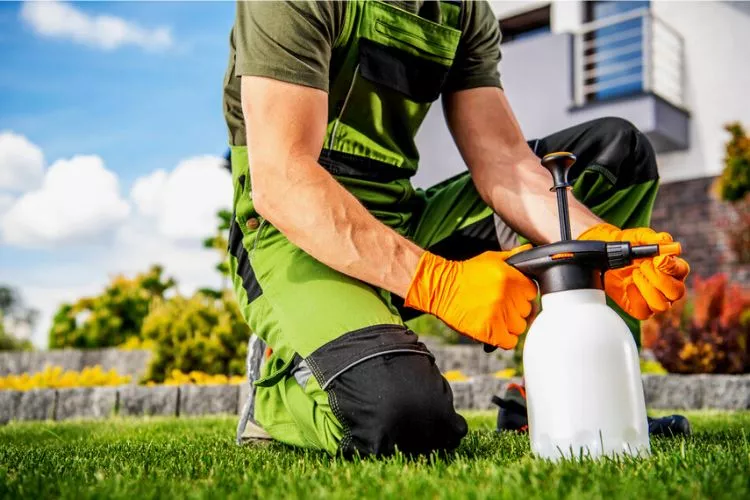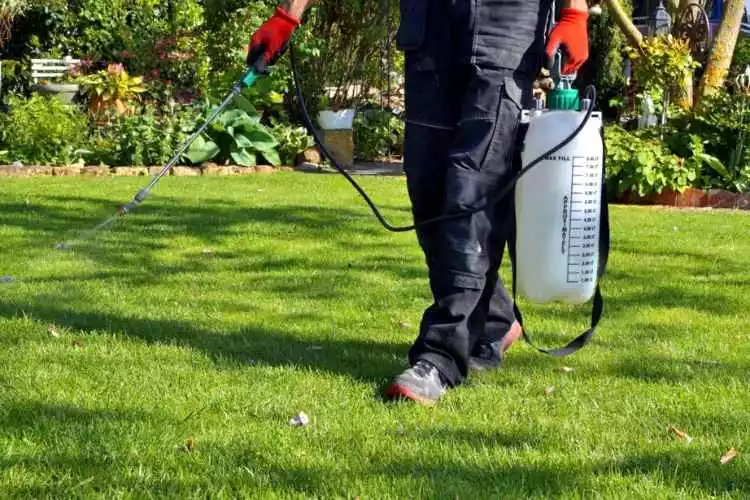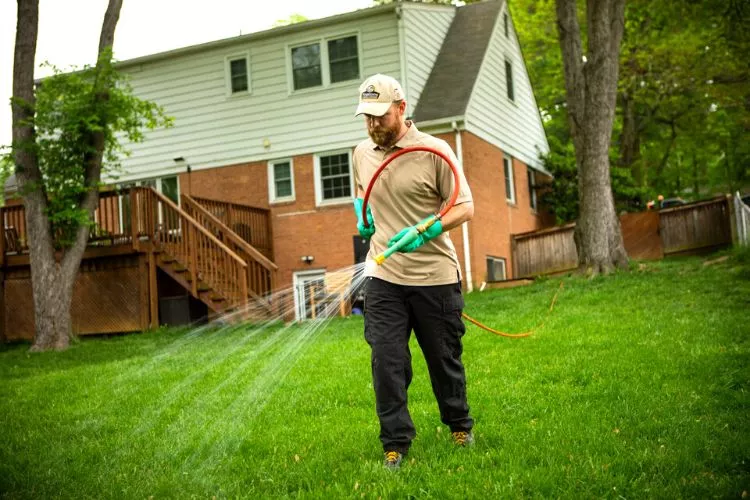Fungicides are chemical substances that inhibit or kill fungi, preventing the spread of infection and damage to the grass. However, fungicide application must be made correctly for it to be effective. This brings us the question can you apply fungicide to wet grass? Well, it depends on what type of fungicide you are applying, I have explained everything in detail below.

Can You Apply Fungicide to Wet Grass?
Yes, you can apply fungicide to wet grass depending on the types of fungicide. Applying fungicide to wet grass can effectively treat and protect the lawn from disease and insect infestation if you are using systemic fungicides. But when you are using contact fungicide, it is not recommended to apply it to wet grass. However, when doing so, it is important not to over-saturate the foliage as this can increase the risk of runoff into nearby water sources.
systemic fungicides are absorbed through roots, so the moisture in grass will help it to get absorbed better, that’s why it is good to apply systemic fungicides on wet grass. On the other hand, contact fungicide kills on contact as the name suggest. So applying contact fungicide to wet grass will dilute it and will reduce its effectiveness.
Additionally, when applying fungicide to wet grass, the substance must be evenly distributed across the infected area to effectively treat it.
Risks of Applying Fungicide to Wet Grass
Applying fungicide to wet grass can effectively protect your lawn from disease and insect infestation. However, there are potential risks associated with the practice.
If sprayed in large quantities onto the wet grass, fungicides may harm beneficial organisms such as earthworms and other beneficial insects. As such, it is important to exercise caution when applying fungicide to wet grass to ensure its safe use and prevent potential human and ecological health damage.

Best Time to Apply Fungicide
The best time to apply fungicide to your grass is during the growing season, usually from late spring through summer. Factors such as weather, temperature, and soil conditions should be considered when deciding when to spray. If the temperature is too low or if there are drought-like conditions, it likely won’t be effective.
Humidity in the air can also affect the rate at which the grass will absorb the fungicide. Additionally, if the soil moisture content is too low, then there will not be enough water for the lawn to absorb the chemical. Therefore, it would be best to wait until soil moisture content, and ambient humidity reach suitable levels before applying fungicides.
Furthermore, application timing should also depend on disease types, as some fungal diseases thrive better in wet weather while others prefer dry conditions. In my experience it is better to apply fungicide in the early morning.

To get the best results when applying fungicide, planning your application in advance is important. Start by gathering information such as the type of disease and its progress, weather conditions, temperature, and soil moisture content to determine the right time to apply the fungicide.
Once you have decided on a date, ensure all necessary equipment, such as sprayers and protective clothing, are available. Be sure to read and follow all instructions provided with the product to ensure proper dilution and application methods.
Additionally, be mindful of any potentially vulnerable living organisms within the vicinity so as not to cause harm during treatment. Finally, conduct a thorough inspection after applying the fungicide to confirm its effectiveness before taking further steps.
Following these steps can help you achieve maximum treatment efficacy and protect your lawn from disease-causing pests and pathogens.
You May Also Find Helpful: Should You Water The Lawn After Applying Fungicide? | Sod Is Turning Brown: Reason And Solution
Frequently Asked Questions (FAQs)
Should you apply fungicide before or after rain?
It is generally recommended to apply fungicide before the rain, as rain can wash away the product and reduce its effectiveness. Applying fungicide before rain allows it to dry and adhere to plant surfaces before any potential infection occurs.
Should I water before applying fungicide?
It is generally recommended to water before applying fungicide, as this can help the product adhere to plant surfaces and be more effective. However, reading the product label for specific instructions and recommendations for optimal use is important.
Can you spray fungicide on dew?
Spray fungicide on dewy plants is generally not recommended, as the moisture can dilute the product and reduce its effectiveness. It is best to wait until the dew has dried and the plants are dry before applying a fungicide for maximum effectiveness.
What month do you apply a fungicide?
The month(s) you should apply fungicide will depend on the specific plant and the type of fungus you are trying to prevent or control. Different fungal infections may have different seasons or stages in which they are most active, so it is important to identify the specific disease and follow the product label instructions for optimal fungicide application timing. In general, fungicides can be applied preventatively before the start of the growing season or during periods of high humidity or rainfall when fungal infections are most likely to occur.
Conclusion:
In conclusion, while it is possible to apply fungicide to wet grass, it is generally not recommended due to the reduced effectiveness of the product. Waiting for the grass to dry before the application is the best approach to ensure optimal adherence and disease control.
Proper identification of the disease and following the label instructions for the specific fungicide product are also important for safe and effective use. By taking these precautions, homeowners can effectively control and prevent fungal diseases on their lawns.


